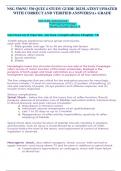Exam (elaborations)
NSG 530/NU 530 QUIZ 4 STUDY GUIDE 2023/LATEST UPDATED WITH CORRECT AND VERIFIED ANSWERS/A+ GRADE NU 530 Advanced Pathophysiology Study Guide Quiz 4 Cervical cord injuries- serious complications Chapter 16
- Course
- Institution
NSG 530/NU 530 QUIZ 4 STUDY GUIDE 2023/LATEST UPDATED WITH CORRECT AND VERIFIED ANSWERS/A+ GRADE NU 530 Advanced Pathophysiology Study Guide Quiz 4 Cervical cord injuries- serious complications Chapter 16
[Show more]



